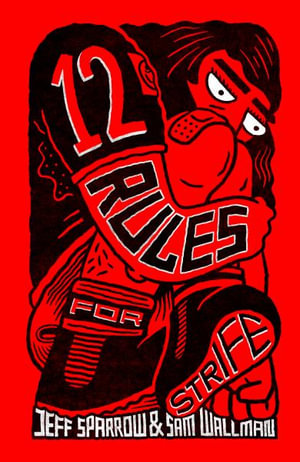12 rules for strife by Jeff Sparrow & Sam Wallman

The 12 rules for strife canvas the ways in which workers can stand against oppression. Some are not much more than 'motherhood' statements, like ‘together we are strong' and some need explanation like ‘reject smug politics'. Number six, 'choose strife' seems to contradict number ten, “practise persuasion'. However, the attractive little book (categorised 'gift/politics') is all about the graphics. The bold black and red of the cover echoes the idea of Mao’s 'little red book' and the iconic red raised fist graphic used to represent the struggle of workers since early last century. There is no narrative, just panels of graphics varying in style from comics to some reminiscent of linocuts, echoing the posters and handbills of past workers solidarity movements, with a bit of quirky Mambo like style thrown in. The content echoes historical aspects of the recognition of workers rights, but one of the only concrete examples is that of the 1973 'Pink Bans' striking against discrimination and anti-gay laws. There are contradictions like the page where the text says 'it is important to reject slurs and stereotypes and to use respectful language’ with a graphic of someone spraying poison from a backpack emblazoned with a skull and crossbones, and later feeding dogs with chocolate, clearly marked ‘do not feed to dogs'. Earlier (there are no page numbers) a boss is depicted as white man in a suit, gold wrist watch, top hat and clutching a wine glass; a stereotype if ever there was one. Towards the second half of the book where it tries to comment on the issues around social media and the not-for-profit industries the message gets a bit confused, and it may have been better to separate the historical side of the struggle of the workers from the modern issues confronting our workforce, where the distinction between the employer and employee has become more complex. However, many of the images will prompt readers to think about how their actions and the actions of groups can create change in our society for the better and tracking down some of the influences in the graphic styles could be an interesting exercise for design students. The authors, Jeff Sparrow and Sam Wallman are well placed to put together this book and have provided a guide to further reading.
Themes: Workers and unions, Political activism.
Sue Speck